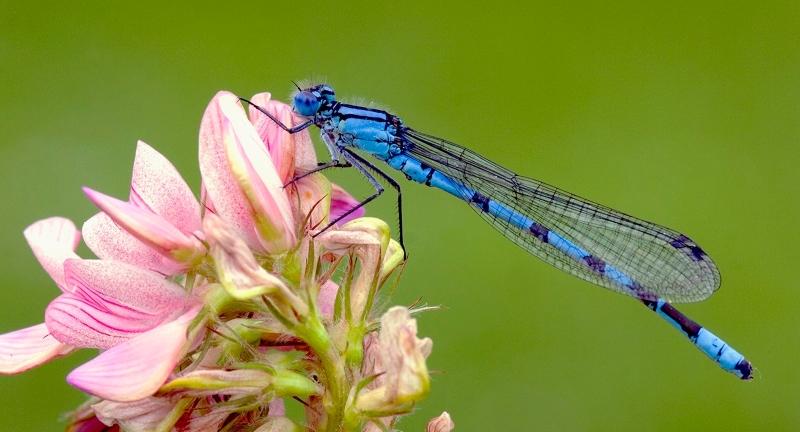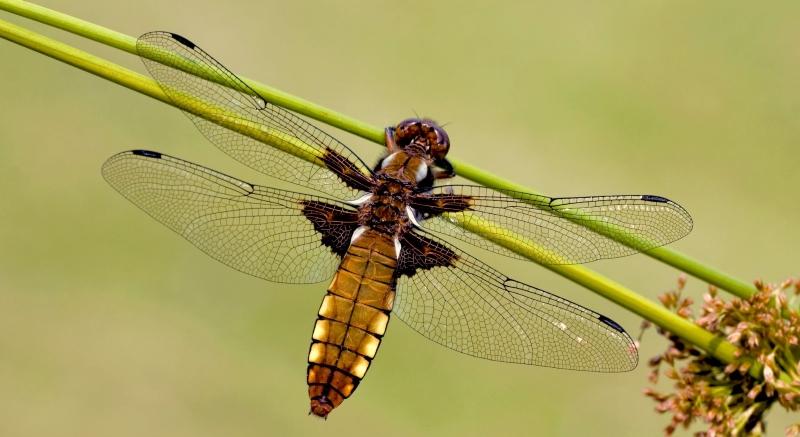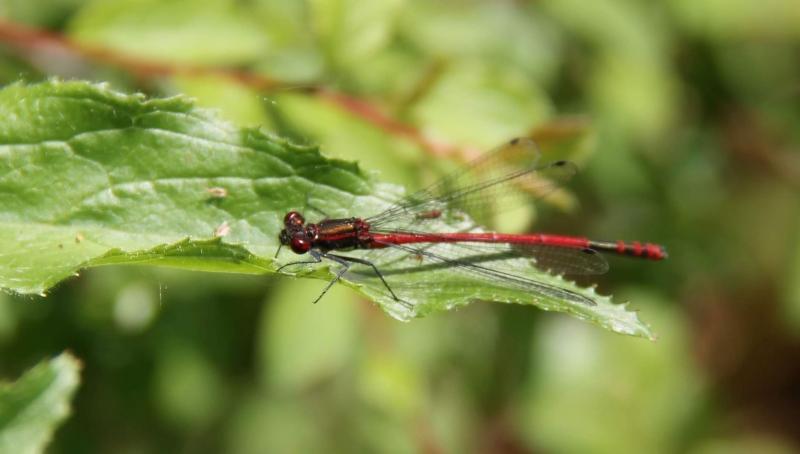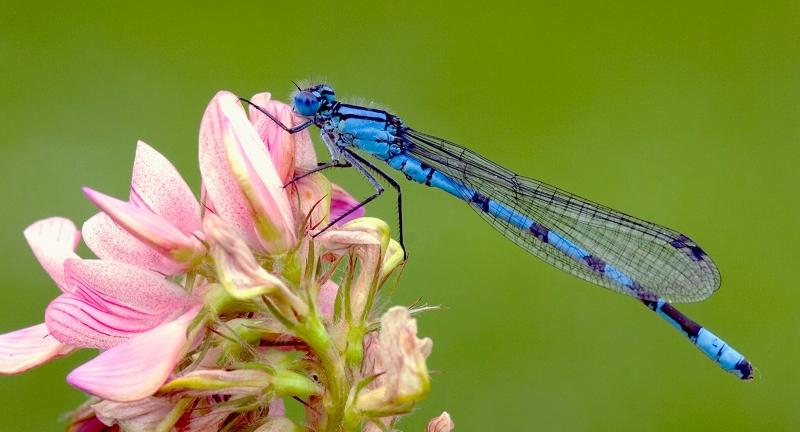
Knowing your dragonflies from your damselflies
The days are getting longer and warmer, raising water temperature in the ponds and streams in the Forest. Soon we will be seeing the beautifully coloured jewelled dragonflies and damselflies return to the skies. Volunteer, Alan, shares his knowledge about these wonderful insects and his top tips to help you identify them.
Inquisitive insects
Contrary to popular belief, dragonflies and damselflies do not have a sting and their bite, although deadly to other insects, is not strong enough to break our skin. Dragonflies can be very inquisitive and quite often come right up to you to see what you are doing. Members of the biodiversity survey team have even had their clipboard used as a lookout point by an opportunist dragonfly.
For the health of our dragonfly and damselfly populations please do not disturb them. Just sit on the riverbank or pondside and enjoy the spectacle of the free aerial display as they twist and turn in the sunshine.
Characteristics of dragonflies and damselflies
When explaining characteristics of the dragonflies and damselflies, it is easiest to first look at two things – flight zones and basic anatomy.
Flight Zones
When looking at dragonflies and damselflies, consider three zone levels (taken as an approximation):
- Zone 1 – water level up to 1 metre
- Zone 2 – water level 1 metre up to 2 metres
- Zone 3 – water level 2 metres and above.
Basic Anatomy
Dragonflies and damselflies are insects and so their body is divided into three sections: head, thorax and abdomen:
- Head – almost completely covered by the large compound eyes, especially in dragonflies
- Thorax – the central part of the body to which are attached the wings and legs
- Abdomen – the final part of the body often referred to as the tail. This is divided into ten sections which we number S1 to S10, with S1 being closest to the thorax.
The scientific name for dragonflies and damselflies is odanatan, and you can find a useful diagram on Odonata.org.uk (link to: https://www.odonata.org.uk/id-aids/anatomy-terminology/dragonfly-anatomy/)
Identifying early flying dragonflies and damselflies
If you have a pond in your garden, or pass a pond or stream when walking, you may spot some early flying odonata. Here is Alan’s spotter’s guide to help you to identify them.
Dragonflies
Dragonflies are generally powerful and fast fliers, often seen quartering the air over a pond or darting out from a foliage perch to catch insects.
Emperor dragonfly

The emperor dragonfly is one of our earliest (if not the earliest) flying dragonfly and it is also our largest flying insect.
The male is easily recognisable with its blue eyes, apple green thorax and bright blue abdomen. The female is far more secretive and darker green all over, but both have the same marking of a black longitudinal line along the top of their abdomen.
Both male and female have transparent wings, not counting the wing spot.
They are also recognisable from their characteristic flight of “hawking”, a continuous flight around as it searches for food, hence its name classification “Hawker”, and their very aggressive nature towards all other dragonflies. They often appear to fly with a slight downward curve to their abdomen.
Flight zone: All
Broad body chaser

The broad body chaser is smaller than the emperor but more heavily built. Its abdomen is wider and flatter than the typical cylinder shape of most dragonflies.
The male’s head and thorax is brown in colour, but the abdomen is a soft pale powder blue with small yellow half circle shapes down both sides. The female is more of a constant brown, with no blue, but still with the distinctive yellow half circle marking.
Both male and female have brown triangular markings on both wing bases at the thorax and only one wing spot per wing
It often gives the impression of chasing other insects through the water margin foliage, hence its name classification “chaser”.
The powder blue colour tends to wear off and fade as it gets older and some confusion may occur with the black tail skimmer, but black tail skimmers are lighter built and do not have the dark wing markings.
The only other confusion could occur with its close relative the four spot chaser. The four spot has, as its name implies, four wing spots, two per wing. It also lacks the powder blue colouring of the broad-bodied chaser.
Flight zone: 1 and 2
Damselflies
Damselflies tend to be smaller than dragonflies and fly with a slower more delicate flight.
They are commonly found near and around the edges of ponds and rivers, flying out over the water where there are surface plants on which to lay their eggs.
Below are descriptions of the males, as females are often more difficult to identify, with some of them having two or three variants.
Large red damselfly

This is perhaps the easiest damselfly to identify that you are likely to encounter in this area. If you see a damselfly that is prominently red with some black bands and marks around abdomen S6 to S8, then you have a male large red damselfly.
The only damselfly that it can be confused with is the small red damselfly, but these are not found within our area.
Flight zone: 1
Blue damselflies
These are the damselflies that probably cause the most confusion when trying to identify them. At this time of year, I often get asked “I have small blue damselflies on my pond and when I look in my book there are too many blue ones, so what are they?”
If it is dark or black and abdomen S8 is blue, then this is not a blue damselfly, it is a blue-tailed damselfly!
All blue damselflies are blue with black markings. There are eight species of blue damselflies found in the British Isles, but luckily for us only two are found in our area of the country.
The method of looking at S2, S8 and S9 applies to all blue damselflies and can be used to identify which of the blues you have, as these are unique to each one.
Common Blue

Look at S2, it is blue and there is a black mark that looks like a band with a mushroom like blob above.
S8 and S9 are completely blue with two very small spots on S8 (if you can see them).
Flight zone: 1
Azure Blue

Look at S2, it is blue and there is a black mark that looks like a letter “U”, or some say a drinking tumbler.
S8 is blue with the very small spots, similar to the common blue.
S9 is blue but there are two black triangles along the margin with S10, which looks like the top half of a bow tie.
Flight zone: 1
You can think up little memory joggers to help you remember which one is which. I remember them as the common blue is common and only has a mushroom and blue markings, whereas the azure blue is posh because he has a whisky glass and a bow tie.
It is no longer necessary to capture odonata to identify them. Take a photograph on your phone and look them up afterwards. If you need some help identifying them, then take a look at the British Dragonfly Society’s helpful identification guide.
Become a biodiversity volunteer
If you are interested in wildlife and would be keen to take part in some wildlife surveys, you can find out more on our volunteering web page and signing up to our volunteer e-newsletter.



